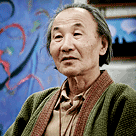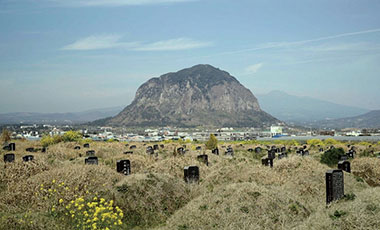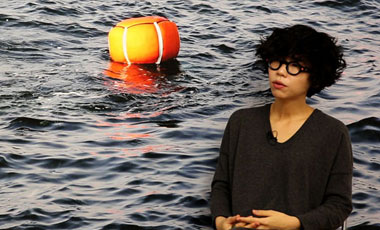TheArho has prepared a program called "relay interview" to meet with those in the arts scene and to learn more about their activities and perspectives. This is how the relay interview has gone so far. Jeong Yong-guk (artist), the first interviewee, chose Lee Dae-beom (independent curator, art critic) as the next guest and interviewed him. Lee then chose Hyun See-won (independent curator) to interview him. In his tum, Hyun chose Joo Jae-hwan (artist) to meet with him. When an intervie-wee chooses the next person, he or she should also consider the circumstances of the next interview. Meanwhile, nobody knows who will be chosen as the next interviewee. Let's then listen to the story coming from the close relationship between the interviewee and the interviewer.
-

- Joo Jae-hwan / Artist Joo Jae-hwan started studying Western painting at the College of Fine Arts of Hongik University but in the first year (1960), he dropped out. Since he first appeared on the arts scene in 1980 on the occasion of the exhibition 《Reality and Remarks》, he has participated in grass-roots activist art movements. He has held four individual exhibitions and exhibited his works at major collective exhibitions.
'What I Am Proud of Is Only the Garbage I Have Thrown Away
Hyun See-won (as 'Hyun' below): What I have felt special about your works was the "smile." Compared to other grass-roots activist works of art, your works make me feel that there is a smile in them. I really like that.
Joo Jae-hwan (as 'Joo' below): I generally tend to transform heaviness to lightness or bitterness into sweetness. However, I have also created many works with heaviness, particular in the case of oil paintings. So it is difficult to define my art world with one word. A work comes out unconsciously so my works can be on this or that side, just like a see-saw. But I'm totally unconscious of the process.

Hyun: It seems that fury is hidden behind the "smile" in your works as in the case of "The Sound of Smile" and "A Stowaway's Smile."
Joo: Artists have different life stories. I'm in my early 70's. It was in the 1940's when I was an infant. At that time, Korea was colonized by Japan and I sometimes remember the Japanese police carrying a sword and riding a horse. Korea was liberated when I was five. As I remember, adults gathered together in the living room to listen to the radio. They were listening to the message of the Japanese emperor who was capitulating. Later on, I went to elementary school and in the fourth year, the Korean War broke out. My house was located in Jongro-4 ga near Changgyeong Palace. As I remember, a North Korean tank fired a shell and the shell struck my house. My family was running a hardware store on the street. A North Korean soldier who hadn't turned 20 yet and who thus seemed like my big brother said to my grandmother in his North Korean accent, "Ma'am, please give me a glass of water." She then put some sugar into water and gave it to him. We were under the control of the North Korean Army for three months. American combat planes bombed the area quite often. Three months passed and during the Battle of Inchon, Seoul was recaptured. A few months later, the Third Battle of Seoul started and the Chinese Army had intervened so we had to flee to my mother's parents' house in Okcheon, a city located to the south of Daejeon. I wasn't able to go to school and I had to peddle eggs near a bus stop. Afterward, Seoul was recaptured on September 18 and I went back to Seoul.
Hyun: Did you sell eggs?
Joo: Sure, I was working part-time. Haha... Here is the historical background of my work. When I was a little child, the country went through the Japanese colonial period and the Korean War, a civil war. After beginning a degree in Western painting at Hongik University in the 1960's, the April Revolution started. I was wandering around in the Gwanghwamun area, watching the protesters. Then came the May 16 coup and the Park Chung-hee regime which lasted for 18 years. He made efforts to aid the country's economic growth, but he caused damage to its democratization and many horrible incidents, such as the People's Revolutionary Party Incident, happened. Chun Doo-hwan then served as the president in the 1980's and was the leader during the Gwangju Democratization Movement. At that time, my colleagues and I were preparing the first exhibition of 《Reality and Remarks》 at the Art Hall (today's Arko Art Center) to criticize the situation. The government considered it rebellious and it turned off all the lights in the hall so we had to distribute candles for the audience to attend the exhibition. It would have been the first candlelight exhibition ever in the history of exhibitions held in Korea. To summarize, I haven't follow the so-called "normal" route but I have zigzagged, walking through dirty alleys during my infancy, adolescence and adulthood. I am a lively person so when anything happens, I never hide myself in my room but I try to digest the incident. I think this is how I create satiric works and why some of my paintings look dark and heavy.
Hyun: You dropped out a year after starting a degree in Western Painting at Hongik University...
Joo: I attended the school only for a semester. At that time, low-income families were very poor. I dropped out because it was hard to pay the tuition fees. I was also carried away by ill-advised bravery, saying to myself, "Even if I had the money for tuition, I would rather just buy some paints and start painting. Why would I go to school to learn how to paint?" In other words, I dropped out partly for financial reasons and partly out of bravery.
Hyun: You said that your childhood dream had been to become a journalist or an astronomer, didn't you?
Joo: These days, too, young people find it hard to choose their career. As for me, I thought, "Will I be a journalist, or how about an astronomer?" Now, I'm a painter. Looking back, my dream of becoming a journalist helped me work in the publishing industry for a long time. My other dream of being an astronomer has allowed me to draw the universe. I think that people's childhood dreams sometimes appear again even when they are working at a totally different job.
Hyun: You had a variety of jobs after leaving college. For example, you worked as a night watchman in the 60's, right?
Joo: It was in 1968. When Kim Shin-Jo's team of North Korean commandos came down to South Korea, I was working as a night watchman at the police substation located near the main gate of Seoul National University Hospital. Tension was mounting as we received clubs before patrolling the neighborhood. Night watchmen help policemen. We formed groups of two or more and took turns from midnight to 4 a.m. As I remember, we were in a group of six. We patrolled the neighborhood, hitting walls with our clubs. It helps prevent crime and when they hear the sound, people check if they locked the door. It's actually a very romantic job. Haha... I remember that there was a zoo in Changgyeong Palace. In spring, there was a cherry blossom festival at night and the palace was full of these flowers. There were so many people who came to see them that the trams weren't able to move. After midnight, few of them were there. The tiger roared sometimes and the sound spread throughout the city. Imagine hearing a tiger's roar on a calm night. How would it be if a tiger roared in the city today? At dawn, lots of housewives carrying pots came from the Miari area to Wonnam-dong, my neighborhood area. That is because in Wonnam-dong, there was a tofu factory and extremely poor housewives came here to buy tofu residue. Downtown, young men went to Seoul National University Hospital very early in the morning. Do you know why? They went there to sell their blood. There were so many "blood sellers" who had to take a number and wait their turn. Some were selling their blood and others were buying tofu residue... That was a typical scene of the 1960's.
Hyun: Tofu and blood...
Joo: Right. Tofu was too expensive but tofu residue was cheap. That's how we went through poverty, with tofu residue and blood.
Hyun: Did you serve as a night watchman for about a year?
Joo: For about two years. I remember that curfew violators were taken to the police substation. Few of them said that they had done anything wrong and almost all the violators tried to make an excuse, making up such and such reasons why they violated the curfew and justifying themselves. Hahaha... One more thing... there were some crazy people, especially women, who looked like midnight ghosts.
Hyun: Working as a night watchman and doing other jobs, did you continue to think that you would be an artist?
Joo: At that time, no. The same is true for today that you don't know where to work if you don't hold a college degree. That is why Korean parents put their children into a "college entrance prison" from a very early age to make them go to college. There are also so many temporary workers. Without any degree, I was thankful that I was working as a night watchman. Thinking about drawing at that time? Hmm... I couldn't afford to think about painting because I had to focus on surviving.
Hyun: Then, when did you start drawing?
Joo: In the 1970's, something strange happened. It seems that after piling up creativity in your body, you let it out naturally, just like excreting waste from the body. Just like that, the desire to create seems to be fermented naturally. When I was jobless, I suddenly wanted to do something. I was living in the Wangshipri area, a mountainous neighborhood. My grandmother and I lived in a tiny room together. I didn't have any money so I went to see alumni who were a little wealthy and said, "Hey, I want to draw and why don't you guys buy the paintings in advance? After the exhibition I'll give them to you." Adjusting the amount to today's price, I would have received 50,000 won from each of them and collected about 500,000 won. Hahaha.. I was paid for my paintings in advance. There was a secondhand bookstore in the Cheonggyecheon area. There, I bought magazines like Time or women's magazines with many pictures at low prices. After that I made collages and there were about 30 or 40 of them as I remember. The size was 33.4 cm × 24.2 cm. In the alley behind the Sejong Center in Gwanghwamun, there was an old-fashioned bar called Joksaem. It had a thatched roof and sold makgeolli(Korean rice wine) and the place was very famous. Kim In-hwan, a friend of mine then serving as an art critic, encouraged me to exhibit my works in the bar. I then hung the paintings on the wall in the bar, called my alumnus to come have a drink and I distributed the works one by one. It was almost 40 years ago. Wanting to see my works again, I recently told them to look for them but none of them kept the collages. Haha... Everyone had thrown them away. I feel so sorry because nothing remains to show me what I did 40 years ago.
Hyun: When making the collages, did you put some words on them?
Joo: That's the part that makes me so sorry. On one of the collages, I added a poem written by the Korean poet Yi Sang and there was another one in black and white. I still want to see them again but I can't find the person who has it.

Seewon Hyun
Working as an independent curator, she plans exhibitions and writes on images and art.


